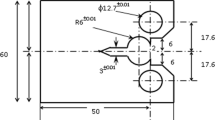Abstract
The mixed mode fracture of a high strength rotor steel has been investigated at room temperature using single edge notched specimens. In mode I, and for limited amounts of shear loading, the steel exhibited cleavage fracture. For conditions near mode~II ductile fracture occurred. A transition from brittle to ductile fracture occurred for mixed mode loading. Finite element analysis provided estimates of the extent of near crack tip yielding and elastic-plastic stress intensity factors. Test results agreed with the maximum tensile stress (MTS) criterion for small scale yielding for limited amounts of shear loading. The load for mode II fracture was lower than predicted from the MTS criterion, but higher than predicted from plastic collapse predictions. Observed fracture angles where in broad agreement with the predicted fracture mechanisms. The load for the transition from brittle to ductile fracture was found to agree approximately with the predicted load.
Similar content being viewed by others
References
ASTM E813, (1994). JIc, a measure of fracture toughness. Standards of the American Society of Testing andMaterials 3(1), Philadelphia, USA.
BSI BS7448. (1991). Methods for determination of KIc, critical COD and critical Jvalues of metallic materials. British Standards Institution, London, UK.
Budden, P.J. (1987). The stress field near a blunting crack tip under mixed modes 1 and 2. Journal of MechanicalPhysics and Solids 35(4), 457–478.
Budden, P.J. (1988). The effect of blunting on the strain field at a crack tip under mixed modes 1 and 2. Journal ofMechanical Physics and Solids 36(5), 503–518.
Budden, P.J. and Jones M.R. (1989). Mixed mode fracture. CEGB Research Report, RD/B/6159/R89.
Chao, Y.J. and Liu, S. (1989). On the failure of cracks under mixed–mode loads. International Journal of Fracture 87, 201–223.
Cotterell, B., Lee, E. and Mai, Y.M. (1982). Mixed mode plane stress ductile fracture. International Journal ofFracture 20, 243–250.
Davenport, J.C.W. (1993). Mixed mode elastic–plastic fracture, PhD Thesis, University of Bristol, UK.
Davenport, J.C.W. and Smith, D.J. (1993). A study of superimposed fracture modes I, II and III on PMMA. Fatigueand Fracture of Engineering Materials and Structures 16(10), 1125–1133.
Davenport, J.C.W. and Smith, D.J. (1994). Mixed mode ductile tearing in a ferritic steel. ECF10, StructuralIntegrity: Experiments–Models–Applications, Eds., K–H Schwalbe and C Berger, 901–910.
Erdogan, F. and Sih, G.C. (1963). On the crack extension in plates under plane loading and transverse shear. Journal of Basic Engineering 85D, 519–525.
Green, G. and Miles, L. (1985). Use of the J–integral estimation techniques to determine critical fracture toughness in ductile steels. CEGB Report, SWR/SSD/0632/R/85.
Hallback, N. and Nilsson, F. (1994). Mixed–mode fracture behaviour of an aluminium alloy. Journal of theMechanics and Physics of Solids 42(9), 1345–1374.
Hellen, T.K. (1991a). Numerical post–yield fracture criteria comparisons on plane strain test specimens. EngineeringFracture Mechanics 39, 269–285.
Hellen, T.K. (1991b). BERSAFE Release User Guide. CEGB, Berkeley Nuclear Laboratories, Berkeley, Gloucester, UK.
Hellen T.K. and Blackburn, W.S. (1975). The calculation of stress intensity factors for combined tensile and shear loading. International Journal of Fracture 11, 605–617.
Kamat, S.V. and Hirth, J.P. (1996). Mixed mode I/II fracture toughness of 2034 aluminium alloys. Acta Materialia 44(1), 201–208.
Li, F.Z., Shih, C.F. and Needleman, A. (1985). A comparison of methods for calculating energy release rates. Engineering of Fracture Mechanics 21, 405–421.
Maccagno, T.M. and Knott, J.F. (1989). The fracture behaviour of PMMA in mixed modes I and II. Engineeringof Fracture Mechanics 34, 65–86.
Maccagno, T.M. and Knott, J.F. (1991). The low temperature brittle fracture behaviour of steel in mixed modes I and II. Engineering of Fracture Mechanics 38(2/3), 111–128.
Maccagno, T.M. and Knott, J.F. (1992). The mixed modes I/II fracture behaviour of lightly tempered HY130 steel at room temperature. Engineering of Fracture Mechanics 41(6), 235–252.
Miller, A.G. (1988). Review of limit loads of structures containing defects. International Journal of PressureVessels and Piping 32, 197–328.
Milne, I., Ainsworth, R.A., Dowling, A.R. and Stewart, A.T. (1988). Assessment of the integrity of structures containing defects. International Journal of Pressure Vessels and Piping 32, 3–104.
Putatunda, S.K. and Banerjee, S. (1984). Effect of size on plasticity and fracture toughness. Engineering ofFracture Mechanics 19, 507–529.
Shih, C.F. (1974). Small scale yielding analysis of mixed mode plane strain crack problems. Fracture Analysis,ASTM STP 560, 187–210.
Sih, G.C. (1972). Methods of analysis and solution of crack problems, Nordoff International Publishing.
Sutton, M.A., Zhao, W., Boon, M.L., Reynolds, A.D. and Dawicke, D.S. (1997). Prediction of crack growth direction for mode I/II loading using small–scale yielding and void initiation/growth concepts. InternationalJournal of Fracture 83, 275–290.
Tohgo, K. and Ishii, H. (1992). Elastic–plastic fracture toughness test under mixed mode I/II loading. EngineeringFracture Mechanics 41(4), 529–540.
Yokobori, T., Yokobori, A.T., Sato, K. and Omotami, M. (1983). The effects of ferrite grain size on fracture of low carbon steels under mixed modes I and II. Engineering Fracture Mechanics 17, 187–210.
Author information
Authors and Affiliations
Rights and permissions
About this article
Cite this article
Smith, D., Ayatollahi, M., Davenport, J. et al. Mixed Mode Brittle and Ductile Fracture of a High Strength Rotor Steel at Room Temperature. International Journal of Fracture 94, 235–250 (1998). https://doi.org/10.1023/A:1007572406726
Issue Date:
DOI: https://doi.org/10.1023/A:1007572406726




